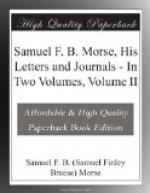“As soon as the necessary apparatus was made I commenced experimenting with it. The greatest obstacle I had to encounter was in the quality of the plates. I obtained the common, plated copper in coils at the hardware shops, which, of course, was very thinly coated with silver, and that impure. Still I was able to verify the truth of Daguerre’s revelations. The first experiment crowned with any success was a view of the Unitarian Church from the window on the staircase from the third story of the New York City University. This, of course, was before the building of the New York Hotel. It was in September, 1839. The time, if I recollect, in which the plate was exposed to the action of light in the camera was about fifteen minutes. The instruments, chemicals, etc., were strictly in accordance with the directions in Daguerre’s first book.
“An English gentleman, whose name at present escapes me, obtained a copy of Daguerre’s book about the same time with myself. He commenced experimenting also. But an American of the name of Walcott was very successful with a modification of Daguerre’s apparatus, substituting a metallic reflector for the lens. Previous, however, to Walcott’s experiments, or rather results, my friend and colleague, Professor John W. Draper, of the New York City University, was very successful in his investigations, and with him I was engaged for a time in attempting portraits.
“In my intercourse with Daguerre I specially conversed with him in regard to the practicability of taking portraits of living persons. He expressed himself somewhat skeptical as to its practicability, only in consequence of the time necessary for the person to remain immovable. The time for taking an outdoor view was from fifteen to twenty minutes, and this he considered too long a time for any one to remain sufficiently still for a successful result. No sooner, however, had I mastered the process of Daguerre than I commenced to experiment with a view to accomplish this desirable result. I have now the results of these experiments taken in September, or beginning of October, 1889. They are full-length portraits of my daughter, single, and also in group with some of her young friends. They were taken out of doors, on the roof of a building, in the full sunlight and with the eyes closed. The time was from ten to twenty minutes.
“About the same time Professor Draper was successful in taking portraits, though whether he or myself took the first portrait successfully, I cannot say.”
It was afterwards established that to Professor Draper must be accorded this honor, but I understand that it was a question of hours only between the two enthusiasts.




